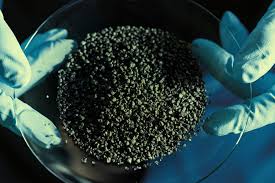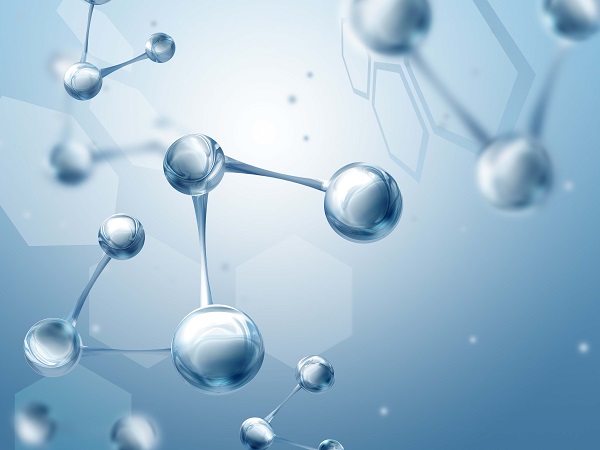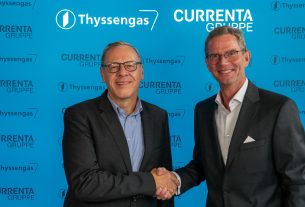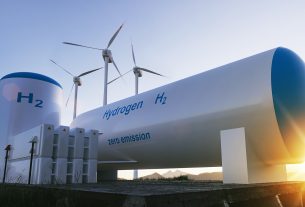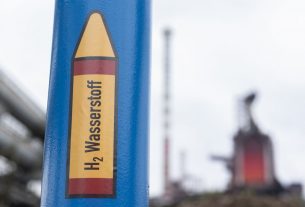The breakthrough of hydrogen seems imminent. However, the problem is CO2 emissions during production. Methane pyrolysis produces hydrogen from natural gas with carbon as a valuable by-product. Call it the turquoise variant. BASF, Shell and also TNO see possibilities.
Currently, the industry already uses a lot of hydrogen. Among other things for the desulphurization of fuels and also for the production of ammonia. This is then used to make artificial fertilizer, for example. Nowadays, this hydrogen is mainly produced from natural gas via steam methane reforming. This is referred to as grey hydrogen, but according to experts you could also call it deep black. After all, natural gas is used in this route both as a raw material and as a source of energy. As a result, enormous amounts of natural gas are used and a lot of CO2 is emitted into the atmosphere. The production of one tonne of hydrogen releases no less than nine tonnes of CO2. With the current climate ambitions, this route is therefore coming under increasing pressure. Fertilizer manufacturers such as Yara in Sluiskil and OCI Nitrogen in Geleen, but also entire industrial clusters such as Rotterdam, Geleen and the Eems Delta are therefore looking for other routes.
Large-scale
A lot of research is currently being done worldwide into cleaner methods of producing hydrogen. In the short term, many companies are using blue hydrogen, capturing CO2 at the chimney and storing it underground (CCS), for example in produced oil and gas fields. Not particularly elegant according to many, but if we want to achieve the Paris Climate Targets and the draft Climate Accord, little can be excluded. Nor can CCS.
Much is expected of water electrolysis in the longer term. The green route, provided, of course, that sustainably generated electricity is used for this. Various parties, including Nouryon and Gasunie, have already announced the first investments in green hydrogen plants. However, much more is needed for a large-scale application. For example, an enormous growth in wind turbines and solar panels is required. Moreover, this route is still very expensive. According to various studies, green hydrogen will only be able to play a significant role by 2030.
Optimistic message
There’s a third option. A relatively underexposed alternative is methane pyrolysis. With a little imagination you could call this the turquoise route, a mixture of blue and green. Natural gas is still the main raw material, next to possibly biomethane. However, its emissions can be enormously reduced and even neutralised.
In this technology, for example, methane is split at high temperature into hydrogen and pure carbon in a molten metal alloy. Without carbon dioxide being formed. In addition to these avoided emissions, extra value is created with the usable carbon. The applications are diverse. For example, additive for steel, filler in car tires, graphite, dye and soil conditioner. A potential growth market. An additional advantage of this turquoise route is that the CO2 emission released during the traditional production of the carbon is also prevented.
Internationally, many parties are mainly doing leexplored research into this route. However, the time now seems ripe to go public with the results. Chemical giant BASF, for example, recently announced that it is seriously investigating the methane pyrolysis option, together with gas producer Linde, steel company Thyssenkrupp and various German research institutes, among others. For BASF, it is one of the group’s intended routes for CO2-neutral growth over the coming decades.
Catalyst
According to the chemical group, its variant uses about a quarter more energy than traditional steam methane reforming. However, the green, electrochemical path requires a tenfold increase, according to researchers at the group. BASF is now preparing the next steps in the research. The first pilot plants are to be built in a few years’ time. Commercial application is expected in the years after 2025.
Shell also seems very interested in the blue-green hydrogen route. The group is working closely with researchers from the University of California Santa Barbara. More than a year ago, this university came out with an optimistic message. Researcher Eric McFarland stated that the addition of a catalyst makes it feasible to compete on price with steam methane reforming. And cheaper than electrolysis anyway. A possible future CO2 tax is not even included in the calculation.
Modular
Closer to home, TNO has also been working on the further development of methane pyrolysis since the beginning of last year. Just like many other parties. In addition to BASF and Shell, Gazprom and various other multinationals are working on it. We are currently talking to various interested production companies,’ says Willem Frens of the research institute. He and Professor Earl Goetheer (TNO and TU Delft) are very positive about the possibilities of the process.
It all seems to be gaining momentum. Goetheer: ‘We want to build a pilot installation around 2021 and commercial application will follow soon after. Scaling up is not particularly complicated with this technology. You have to imagine that the reaction takes place in a bath of molten metal at around 900 degrees Celsius. You can put several in a factory and each molten metal bath is the same. This allows you to build and expand factories in a modular way’. And it’s not rocket science either. Moreover, such a factory has a lot in common with existing installations, such as the production of aluminium. At Aldel Delfzijl, for example, aluminium is produced in hot electrolytic baths.
Filter
The core of the technology is the same in the various research teams. Molten metal forms the basis of the reactor. It is used as a catalyst. Think of nickel, platinum or palladium. The metal is dissolved in a metal that is catalytically inert and has a lower melting point. This can be indium, gallium, tin, lead or bismuth. In general, such a combination has an even lower melting point than the individual components. If you feed methane through this, the hydrogen will rise above it by itself. Carbon is lighter than most metal alloys and therefore floats to the surface after which you can more or less scoop it off. We at TNO have taken an extra step in this respect,’ says Goetheer. We can supply pure carbon by separating it properly from the molten metal. This can make it more valuable for various applications of the carbon. In many applications, contamination with metal particles is not desirable. What’s more, you also want to use the metal sparingly’.
The TNO researchers therefore applied an extra salt layer above the molten metal, heavier than carbon but lighter than the metal. Like a filter. Above the salt layer the carbon is thus created. This can easily be scooped off and extra filtered. Goetheer: ‘It is a simple and efficient solution. Other possibilities are being investigated elsewhere, such as plasmas, but these cost a lot of energy’.
Fluctuate
The process of methane pyrolysis still requires energy to heat the baths with molten metal. Electricity can also be used for this purpose. If this is sustainably generated, then the total CO2 emission is zero. Willem Frens: ‘You need significantly less energy per hydrogen molecule than in steam methane reforming, or in water electrolysis, which makes the process very competitive. That’s why the molten metal technology could be a solution for producing the large quantities of hydrogen that will be needed using limited amounts of wind and solar energy’.
Carbon black
For industry, methane pyrolysis offers entirely interesting opportunities in clusters where there is a high demand for both hydrogen and carbon, as is the case in the Netherlands, for example. Where, for example, the steel industry and the chemical industry are a stone’s throw away from each other. And think also of Rotterdam, where refineries use hydrogen to desulphurize fuels and where a company like Cabot also produces carbon black. And what about the Eems Delta, where a company like BioMCN has already made a start with the production of methanol from hydrogen and CO2, while a little further down the road PPG produces carbon black. This is also the area where a lot of sustainably generated electricity is now coming ashore. In addition, Groningen is also a gas infrastructure hub, which may soon be able to transport hydrogen to the various industrial clusters in the Netherlands, Flanders and Germany. In any case, turquoise hydrogen and carbon offer opportunities for new combinations.
